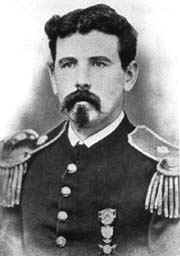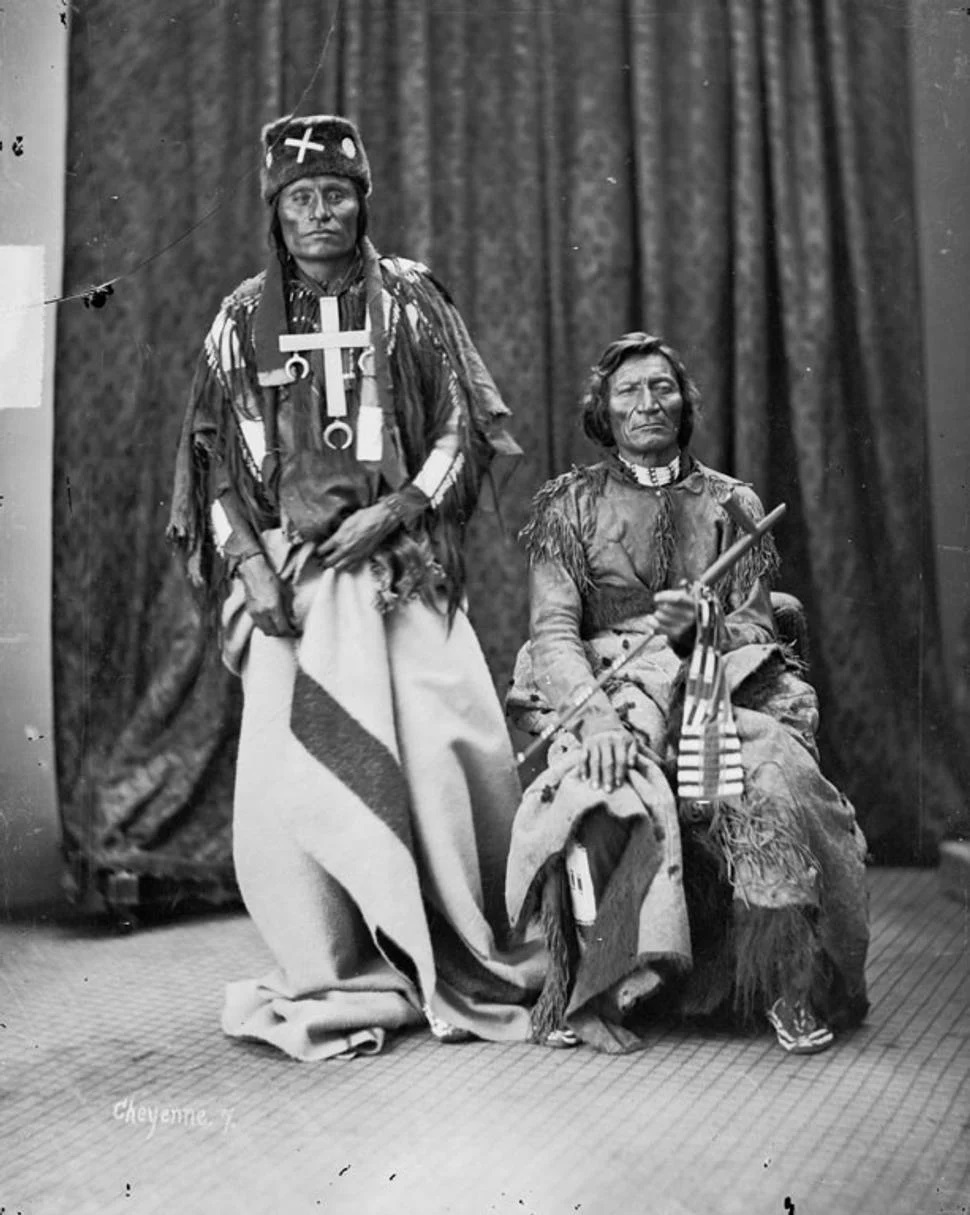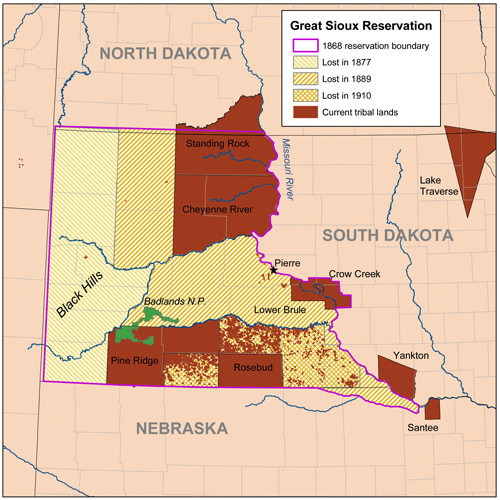|
Northern Cheyenne
The Northern Cheyenne Tribe of the Northern Cheyenne Indian Reservation ( chy, Tsėhéstáno; formerly named the Tongue River) is the federally recognized Northern Cheyenne tribe. Located in southeastern Montana, the reservation is approximately in size and home to approximately 5,000 Cheyenne people. The tribal and government headquarters are located in Lame Deer, also the home of the annual Northern Cheyenne pow wow. The reservation is bounded on the east by the Tongue River and on the west by the Crow Reservation. There are small parcels of non-contiguous off-reservation trust lands in Meade County, South Dakota, northeast of the city of Sturgis. Its timbered ridges that extend into northwestern South Dakota are part of Custer National Forest and it is approximately east of the site of the 1876 Battle of the Little Bighorn. According to tribal enrollment figures as of March 2013, there were approximately 10,050 enrolled tribal members, of which about 4,939 were residing o ... [...More Info...] [...Related Items...] OR: [Wikipedia] [Google] [Baidu] |
Indian Reservation
An Indian reservation is an area of land held and governed by a federally recognized Native American tribal nation whose government is accountable to the United States Bureau of Indian Affairs and not to the state government in which it is located. Some of the country's 574 federally recognized tribes govern more than one of the 326 Indian reservations in the United States, while some share reservations, and others have no reservation at all. Historical piecemeal land allocations under the Dawes Act facilitated sales to non–Native Americans, resulting in some reservations becoming severely fragmented, with pieces of tribal and privately held land being treated as separate enclaves. This jumble of private and public real estate creates significant administrative, political and legal difficulties. The total area of all reservations is , approximately 2.3% of the total area of the United States and about the size of the state of Idaho. While most reservations are small c ... [...More Info...] [...Related Items...] OR: [Wikipedia] [Google] [Baidu] |
Indigenous Peoples
Indigenous peoples are culturally distinct ethnic groups whose members are directly descended from the earliest known inhabitants of a particular geographic region and, to some extent, maintain the language and culture of those original peoples. The term ''Indigenous'' was first, in its modern context, used by Europeans, who used it to differentiate the Indigenous peoples of the Americas from the European settlers of the Americas and from the Sub-Saharan Africans who were brought to the Americas as enslaved people. The term may have first been used in this context by Sir Thomas Browne in 1646, who stated "and although in many parts thereof there be at present swarms of ''Negroes'' serving under the ''Spaniard'', yet were they all transported from ''Africa'', since the discovery of ''Columbus''; and are not indigenous or proper natives of ''America''." Peoples are usually described as "Indigenous" when they maintain traditions or other aspects of an early culture that is assoc ... [...More Info...] [...Related Items...] OR: [Wikipedia] [Google] [Baidu] |
Fort Keogh
Fort Keogh is a former United States Army post located at the western edge of modern Miles City, Montana, Miles City, in the U.S. state of Montana. It is situated on the south bank of the Yellowstone River, at the mouth of the Tongue River (Montana), Tongue River. Colonel Nelson A. Miles, commanding the 5th Infantry Regiment (United States), 5th Infantry Regiment, founded the post in August 1876, in the wake of the Battle of the Little Bighorn, as a base for patrols to prevent the Cheyenne and Sioux involved in the battle from escaping to Canada. The fort was originally known as the Tongue River Cantonment for two years. When relocated one mile west in 1878, it was renamed Fort Keogh in honor of Captain Myles Keogh, who was killed at the Little Bighorn. In 1877, the fort became the headquarters for the newly created District of the Yellowstone (a sub-unit of the Department of Dakota), which was commanded by Miles. The development of Fort Keogh as a military installation soon stimu ... [...More Info...] [...Related Items...] OR: [Wikipedia] [Google] [Baidu] |
Northern Cheyenne Exodus
The Northern Cheyenne Exodus, also known as Dull Knife's Raid, the Cheyenne War, or the Cheyenne Campaign, was the attempt of the Northern Cheyenne to return to the north, after being placed on the Southern Cheyenne reservation in the Indian Territory, and the United States Army operations to stop them. The period lasted from 1878 to 1879. Background Following the Battle of the Little Bighorn attempts by the U.S. Army to subdue the Northern Cheyenne intensified. In 1877, after the Dull Knife Fight, when Crazy Horse surrendered at Fort Robinson a few Cheyenne chiefs and their people surrendered as well. The Cheyenne chiefs that surrendered at the fort were Dull Knife, Little Wolf, Standing Elk, and Wild Hog with nearly one thousand Cheyenne. On the other hand, Two Moon surrendered at Fort Keogh with three hundred Cheyenne in 1877. The Cheyenne wanted and expected to live on the reservation with the Sioux in accordance with an April 29, 1868 treaty of Fort Laramie of which both Dul ... [...More Info...] [...Related Items...] OR: [Wikipedia] [Google] [Baidu] |
Indian Territory
The Indian Territory and the Indian Territories are terms that generally described an evolving land area set aside by the Federal government of the United States, United States Government for the relocation of Native Americans in the United States, Native Americans who held aboriginal title to their land as a sovereign independent state. In general, the tribes ceded land they occupied in exchange for Land grant#United States, land grants in 1803. The concept of an Indian Territory was an outcome of the US federal government's 18th- and 19th-century policy of Indian removal. After the Indian Territory in the American Civil War, American Civil War (1861–1865), the policy of the US government was one of Cultural assimilation of Native Americans#Americanization and assimilation (1857–1920), assimilation. The term ''Indian Reserve (1763), Indian Reserve'' describes lands the Kingdom of Great Britain, British set aside for Indigenous tribes between the Appalachian Mountains and t ... [...More Info...] [...Related Items...] OR: [Wikipedia] [Google] [Baidu] |
Battle Of Washita River
The Battle of Washita River (also called Battle of the Washita or the Washita Massacre) occurred on November 27, 1868, when Lt. Col. George Armstrong Custer's 7th U.S. Cavalry attacked Black Kettle's Southern Cheyenne camp on the Washita River (the present-day Washita Battlefield National Historic Site near Cheyenne, Oklahoma). The Cheyenne camp was the most isolated band of a major winter encampment along the river of numerous Native American tribal bands, totaling thousands of people. Custer's forces attacked the village because scouts had found it by tracking the trail of an Indian party that had raided white settlers. Black Kettle and his people had been at peace and were seeking peace. Custer's soldiers killed women and children in addition to warriors, although they also took many captive to serve as hostages and human shields. The number of Cheyenne killed in the attack has been disputed since the first reports. Background After the Southern Cheyenne and Arapaho signed ... [...More Info...] [...Related Items...] OR: [Wikipedia] [Google] [Baidu] |
Colorado
Colorado (, other variants) is a state in the Mountain West subregion of the Western United States. It encompasses most of the Southern Rocky Mountains, as well as the northeastern portion of the Colorado Plateau and the western edge of the Great Plains. Colorado is the eighth most extensive and 21st most populous U.S. state. The 2020 United States census enumerated the population of Colorado at 5,773,714, an increase of 14.80% since the 2010 United States census. The region has been inhabited by Native Americans and their ancestors for at least 13,500 years and possibly much longer. The eastern edge of the Rocky Mountains was a major migration route for early peoples who spread throughout the Americas. "''Colorado''" is the Spanish adjective meaning "ruddy", the color of the Fountain Formation outcroppings found up and down the Front Range of the Rocky Mountains. The Territory of Colorado was organized on February 28, 1861, and on August 1, 1876, U.S. President Ulyss ... [...More Info...] [...Related Items...] OR: [Wikipedia] [Google] [Baidu] |
Black Hills War
The Great Sioux War of 1876, also known as the Black Hills War, was a series of battles and negotiations that occurred in 1876 and 1877 in an alliance of Lakota Sioux and Northern Cheyenne against the United States. The cause of the war was the desire of the US government to obtain ownership of the Black Hills. Gold had been discovered in the Black Hills, settlers began to encroach onto Native American lands, and the Sioux and the Cheyenne refused to cede ownership. Traditionally, American military and historians place the Lakota at the center of the story, especially because of their numbers, but some Native Americans believe the Cheyenne were the primary target of the American campaign. Among the many battles and skirmishes of the war was the Battle of the Little Bighorn; often known as Custer's Last Stand, it is the most storied of the many encounters between the US Army and mounted Plains Indians. Despite the Indian victory, the Americans leveraged national resources to forc ... [...More Info...] [...Related Items...] OR: [Wikipedia] [Google] [Baidu] |
Oklahoma
Oklahoma (; Choctaw language, Choctaw: ; chr, ᎣᎧᎳᎰᎹ, ''Okalahoma'' ) is a U.S. state, state in the South Central United States, South Central region of the United States, bordered by Texas on the south and west, Kansas on the north, Missouri on the northeast, Arkansas on the east, New Mexico on the west, and Colorado on the northwest. Partially in the western extreme of the Upland South, it is the List of U.S. states and territories by area, 20th-most extensive and the List of U.S. states and territories by population, 28th-most populous of the 50 United States. Its residents are known as Oklahomans and its capital and largest city is Oklahoma City. The state's name is derived from the Choctaw language, Choctaw words , 'people' and , which translates as 'red'. Oklahoma is also known informally by its List of U.S. state and territory nicknames, nickname, "Sooners, The Sooner State", in reference to the settlers who staked their claims on land before the official op ... [...More Info...] [...Related Items...] OR: [Wikipedia] [Google] [Baidu] |
Southern Cheyenne
The Cheyenne and Arapaho Tribes are a united, federally recognized tribe of Southern Arapaho and Southern Cheyenne people in western Oklahoma. History The Cheyennes and Arapahos are two distinct tribes with distinct histories. The Cheyenne (Tsitsistas/ The People) were once agrarian, or agricultural, people located near the Great Lakes in present-day Minnesota. Grinnell notes the Cheyenne language is a unique branch of the Algonquian language family and, The Nation itself, is descended from two related tribes, the Tsitsistas and the Suh' Tai. The latter is believed to have joined the Tsitsistas in the early 18th century (1: 1–2). The Tsitsistas and the Suh' Tai are characterized, and represented by two cultural heroes who received divine articles which shaped the time-honored belief systems of the Southern and Northern families of the Cheyenne Nation. The Suh' Tai, represented by a man named Erect Horns, were blessed with the care of a sacred Buffalo Hat, which is kept among th ... [...More Info...] [...Related Items...] OR: [Wikipedia] [Google] [Baidu] |
Powwow
A powwow (also pow wow or pow-wow) is a gathering with dances held by many Native American and First Nations communities. Powwows today allow Indigenous people to socialize, dance, sing, and honor their cultures. Powwows may be private or public, indoors or outdoors. Dancing events can be competitive with monetary prizes. Powwows vary in length from single-day to weeklong events. In mainstream American culture, such as 20th-century Western movies or by military personnel, the term ''powwow'' has been used to refer to any type of meeting. This usage has been considered both offensive and falling under cultural misappropriation. History The word ''powwow'' is derived from the Narragansett word ''powwaw'', meaning "spiritual leader". The term itself has variants including ''Powaw'', ''Pawaw'', ''Powah, Pauwau'' and ''Pawau''. A number of tribes claim to have held the "first" pow wow. Initially, public dances that most resemble what are now known as pow wows were most common ... [...More Info...] [...Related Items...] OR: [Wikipedia] [Google] [Baidu] |









